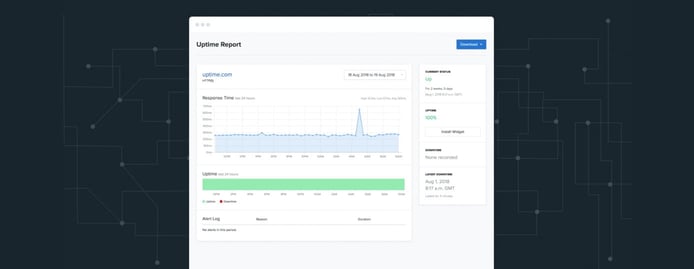
TL; DR: Uptime.com’s comprehensive and highly reliable monitoring solutions deliver enterprise-grade capabilities at accessible price points. The company, which operates from a customer-first perspective, maintains a competitive edge through agile development and attentive support. In the future, Uptime.com has quite a few plans, including the introduction of responsive monitoring tools via artificial intelligence.
Most business leaders have a general understanding of the costs associated with downtime, but based on outages like Costco’s Thanksgiving blunder, few are learning the extent of the threat until it’s too late.
Typically, there’s a hefty price to pay. Consider, for instance, that Amazon made $177.9 billion in 2017 — more than the GDP of Algeria, according to the online magazine Inverse.
Downtime, in this kind of arena, has undeniable impacts. Case in point: In 2018, a glitch caused the massive retailer to lose between $72 million to $99 million on Prime Day, the site’s largest annual sales event.
The same risks apply to us SMBs, albeit on a different scale. Sadly, unlike Amazon, most businesses don’t have the ability to bounce back with quite the same vigor.

Uptime.com is an easy-to-use downtime monitoring service.
Fortunately, downtime monitoring solutions, such as those provided by Uptime.com, can serve as insurance for these catastrophic events.
“We set up synthetic monitors that allow you to check critical components of your application from an outside perspective to make sure they’re working,” said Michael Esposito, Chief Strategy Officer at Uptime.com. “The peace-of-mind component is big.”
Uptime.com’s all-inclusive and highly reliable monitoring tools deliver enterprise-grade functionality at an affordable price point. At the same time, the Manhattan-based company never skimps on customer service. Ultimately, Uptime.com’s goal is to leverage agile development and attentive support to constantly evolve the business based on customer needs.
An Enterprise-Grade Solution Centered on the User
Michael understands the horrors of downtime from personal experience. Before Uptime.com was founded in 2013, Michael led a healthcare organization that invested heavily in pay-per-click Google ads — think more than six figures a month.
The company had a fair amount of lead generation technology in place. But as a healthcare group, it was primarily focused on the direct concerns of its patients, not website monitoring. So when the sales team brought a major outage to Michael’s attention two days after the fact, significant damage had occurred.
“We had two days of downtime, and it cost us almost $60,000 in advertising dollars,” Michael said. “We had to immediately figure out how to prevent this from happening ever again.”
He began searching for a proper web monitoring tool but had trouble finding a solution that was affordable, user-friendly, and reliable. Ultimately, it became clear that the market was remarkably unsaturated, which prompted the founding of Uptime.com.

The comprehensive service offers enterprise-level functionality at an affordable price.
Michael joined forces with Benjamin Byrne, Barak Shohat, and Jay Westerdal — colleagues he had known for a decade and deeply respected — and devised a plan.
“We put our minds together as Co-Founders to determine how we were going to attack the market,” he said. “We decided it was about providing what is today an enterprise-grade monitoring solution with white-glove service and incredible reliability. And we’ve really lived up to that.”
Today, Uptime.com’s internal team has grown to include IT professionals from the United States, Canada, Israel, and the United Kingdom. “By placing customers’ needs at the center of everything we do — whether it’s support or developing software — we’re able to continually improve,” Michael said.
A Competitive Edge in the Face of Market Consolidation
Michael told us Uptime.com had the fortunate opportunity to serve VMware as one of its first customers — and the cloud infrastructure provider remains loyal to the company today.
“We put our stake in the ground with them and said, “Listen, tell us what you want, and we’ll build it,’” he said. “By doing that, really listening to what they wanted, we were prepared to accommodate a good portion of the enterprise market.”
The downtime monitoring market certainly wasn’t fully developed when Uptime.com hit the scene, but that didn’t last long. As the competition began to heat up, Michael said Uptime.com stood out from the pack because of its proprietary algorithm, which makes false positives extremely rare.

Clear and accurate incident reporting helps users confidently track performance.
“It sounds crazy that the challenge the monitoring market faces is reliability, but it’s true,” he said. “There are a lot of false positives in the market, and we attract a lot of business from customers because of it. Our redundancy, architecture, and processes before we send an alert to a consumer severely limits the chance of a false positive.”
Today, Michael said reliability, fair pricing, and the company’s customer-centric approach keep Uptime.com ahead of the competition — even in the face of significant industry consolidation. “It’s the lack of false positives, the user-centricity, the white-glove service,” he said. “We’re here to onboard you. We’re here to work with you and to build features while our competitors won’t give you the time of day.”
In some cases, Uptime.com serves as one of multiple monitoring solutions for large enterprise customers — simply because downtime poses too much of a financial threat to rely on one solution.
“The reality is, a lot of enterprises work with two or three providers because the cost of downtime is so great that having a single source of knowledge is dangerous,” Michael said. “We’re OK with that.”
Agile Development and an Attentive Global Support Team
Michael told us that lately some companies in the application performance market have begun to bleed their services into Uptime.com’s territory, synthetic monitoring.
“I think most would consider that a challenge, but we’re so hyper-focused on what we’re doing that being small is actually a benefit to us,” he said. “We can really listen to the customers and focus on agile development.”
User experience is a primary consideration in every development decision the company names. For example, the setup process makes creating checks and alerts an intuitive process, the dashboard displays vital stats upon login, and the software features easy integration with tools such as Cachet and Jira Service Desk.
Michael said Uptime.com also takes support extremely seriously — a good idea considering that 44% of consumers take their business elsewhere after receiving poor customer service. The team is distributed across the globe and in almost every time zone, with locations including New York, Los Angeles, Israel, Scotland, and Moscow.
“Essentially, we have a 24-hour working cycle, our support team is always available, and we have set a precedent for responding quickly,” Michael said. “And that’s been kind of something that crosses over all areas of our business, whether it’s sales or support.”
Up Next: Responsive Monitoring via Artificial Intelligence
Uptime.com has a lot in the works moving forward in terms of added value for customers, including a powerful proprietary status page set for release around April 2020.
Looking further into the future, the company has big plans for responsive monitoring tools that will leverage the full power of emerging artificial intelligence technologies.
“We’re a little bit away from that, but we’re collecting data right now so that we can use artificial intelligence to detect why a downtime event happened, the root cause, and how we can fix it,” he said. “If you can detect downtime and provide the root cause of it accurately, then you should be able to provide a solution — and that’s where we’re heading.”
The company is also exploring the potential of social media monitoring tools for detecting cases of intermittence service disruptions via user reports.
“It’s about monitoring social media, finding user reports, pulling them into the dashboard, and issuing an alert when you hit a threshold,” Michael said. “We think that’s special because it’s an added component that no one is really providing.”
HostingAdvice.com is a free online resource that offers valuable content and comparison services to users. To keep this resource 100% free, we receive compensation from many of the offers listed on the site. Along with key review factors, this compensation may impact how and where products appear across the site (including, for example, the order in which they appear). HostingAdvice.com does not include the entire universe of available offers. Editorial opinions expressed on the site are strictly our own and are not provided, endorsed, or approved by advertisers.
Our site is committed to publishing independent, accurate content guided by strict editorial guidelines. Before articles and reviews are published on our site, they undergo a thorough review process performed by a team of independent editors and subject-matter experts to ensure the content’s accuracy, timeliness, and impartiality. Our editorial team is separate and independent of our site’s advertisers, and the opinions they express on our site are their own. To read more about our team members and their editorial backgrounds, please visit our site’s About page.

